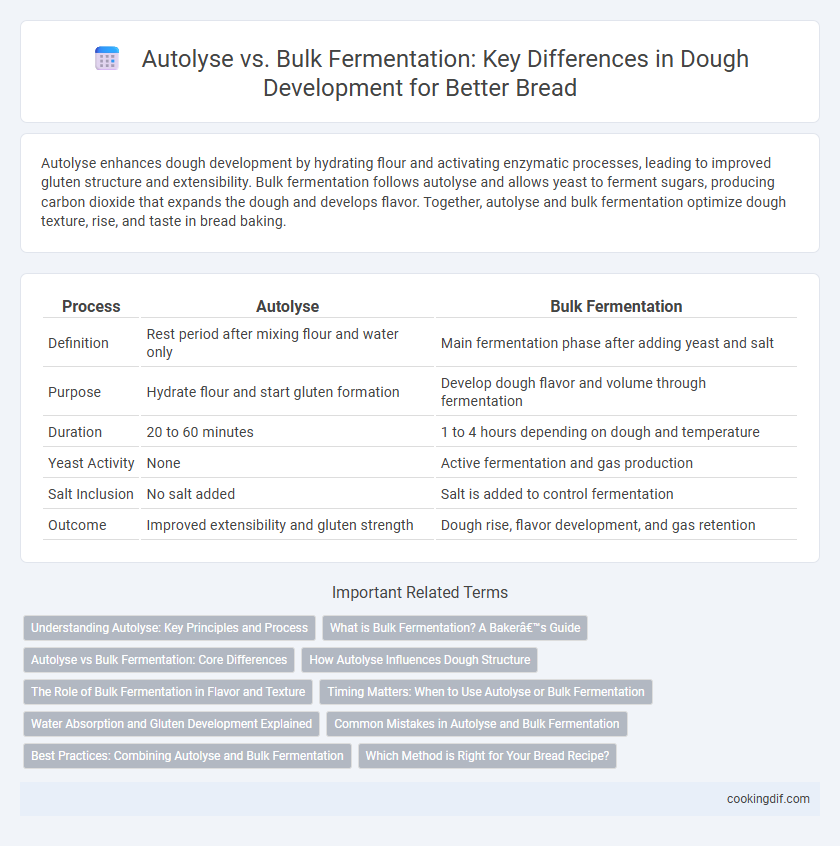Autolyse enhances dough development by hydrating flour and activating enzymatic processes, leading to improved gluten structure and extensibility. Bulk fermentation follows autolyse and allows yeast to ferment sugars, producing carbon dioxide that expands the dough and develops flavor. Together, autolyse and bulk fermentation optimize dough texture, rise, and taste in bread baking.
Table of Comparison
| Process | Autolyse | Bulk Fermentation |
|---|---|---|
| Definition | Rest period after mixing flour and water only | Main fermentation phase after adding yeast and salt |
| Purpose | Hydrate flour and start gluten formation | Develop dough flavor and volume through fermentation |
| Duration | 20 to 60 minutes | 1 to 4 hours depending on dough and temperature |
| Yeast Activity | None | Active fermentation and gas production |
| Salt Inclusion | No salt added | Salt is added to control fermentation |
| Outcome | Improved extensibility and gluten strength | Dough rise, flavor development, and gas retention |
Understanding Autolyse: Key Principles and Process
Autolyse is a dough conditioning technique involving a rest period where flour and water are mixed and left to hydrate before adding yeast and salt, enhancing gluten formation and enzymatic activity. This process improves dough extensibility, reduces mixing time, and develops flavor by allowing enzymes to break down starches into simpler sugars. Unlike bulk fermentation, which focuses on yeast activity and gas production, autolyse emphasizes dough hydration and gluten network development before fermentation.
What is Bulk Fermentation? A Baker’s Guide
Bulk fermentation is the initial resting phase after mixing where dough undergoes yeast fermentation, allowing gluten to develop and flavors to deepen. During this stage, dough volume typically doubles as carbon dioxide is produced, crucial for texture and crumb structure. Proper control of temperature and timing in bulk fermentation ensures optimal dough elasticity and enhances the final bread quality.
Autolyse vs Bulk Fermentation: Core Differences
Autolyse is a resting phase where flour and water are mixed and allowed to hydrate, promoting gluten formation and enzymatic activity without yeast or salt. Bulk fermentation follows autolyse and involves the complete dough, where yeast ferments sugars, producing gas that develops flavor and structure. The core difference lies in autolyse enhancing dough extensibility and enzymatic processes early, while bulk fermentation focuses on leavening, flavor development, and final dough maturation.
How Autolyse Influences Dough Structure
Autolyse improves dough structure by allowing flour hydration and enzyme activity before mixing, which enhances gluten formation and extensibility. During this rest period, amylase enzymes break down starches into sugars, providing yeast with more fermentable substrates for better rise and flavor. Consequently, dough becomes smoother, more elastic, and easier to shape, resulting in improved crumb texture after baking.
The Role of Bulk Fermentation in Flavor and Texture
Bulk fermentation significantly enhances dough flavor and texture by allowing yeast and bacteria to produce organic acids, alcohols, and aromatic compounds that deepen complexity. This stage also improves gluten network strength, resulting in better dough extensibility and gas retention, which contribute to an open crumb structure. Proper control of fermentation time and temperature during bulk fermentation ensures optimal enzymatic activity and microbial growth, directly affecting the bread's final taste and mouthfeel.
Timing Matters: When to Use Autolyse or Bulk Fermentation
Autolyse typically occurs early in dough preparation, lasting between 20 to 60 minutes to improve gluten development and dough extensibility by hydrating flour and activating enzymes before salt and yeast are added. Bulk fermentation follows autolyse in recipes that include it, lasting from 1 to 3 hours depending on temperature and yeast activity, allowing yeast to produce gas and organic acids for flavor and structure. Choosing the timing depends on the desired dough characteristics: autolyse is ideal for enhancing dough strength and handling, while bulk fermentation focuses on yeast fermentation for volume and taste.
Water Absorption and Gluten Development Explained
Autolyse enhances water absorption by allowing flour to fully hydrate before salt and yeast are added, which promotes enzymatic activity that begins gluten development. Bulk fermentation follows, where yeast fermentation produces gas that strengthens gluten networks, improving dough structure and elasticity. Optimal dough development depends on sufficient autolyse for hydration and enzymatic breakdown, combined with bulk fermentation for gas retention and gluten alignment.
Common Mistakes in Autolyse and Bulk Fermentation
Common mistakes in autolyse include adding salt or yeast too early, which inhibits enzyme activity critical for gluten development and starch breakdown. During bulk fermentation, overproofing or underproofing the dough leads to poor gas retention, dense crumb, or weak structure, undermining the dough's final volume and texture. Failing to monitor temperature and time precisely during both stages disrupts yeast activity and fermentation, compromising dough elasticity and flavor development.
Best Practices: Combining Autolyse and Bulk Fermentation
Combining autolyse and bulk fermentation enhances dough development by optimizing gluten hydration during autolyse and promoting yeast fermentation and gas retention in bulk fermentation. Best practices include a 20-40 minute autolyse with flour and water only, followed by kneading and bulk fermentation at controlled temperatures around 75degF to maximize enzymatic activity and yeast growth. This method improves dough extensibility, flavor complexity, and crumb structure in artisan bread.
Which Method is Right for Your Bread Recipe?
Autolyse accelerates gluten formation and enzymatic activity by hydrating flour and water before adding salt and yeast, improving dough extensibility and flavor development in recipes that benefit from a shorter fermentation. Bulk fermentation involves the primary rise of the mixed dough, allowing yeast activity to develop flavor, strength, and texture over a longer period, ideal for complex, slow-fermented breads like sourdough. Choosing between autolyse and bulk fermentation depends on your bread type, desired crumb structure, and fermentation time, with autolyse enhancing dough extensibility and flavor early, while bulk fermentation deepens flavor and strength during the initial rise.
Autolyse vs Bulk Fermentation for dough development Infographic

 cookingdif.com
cookingdif.com